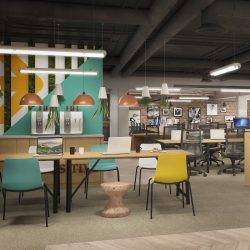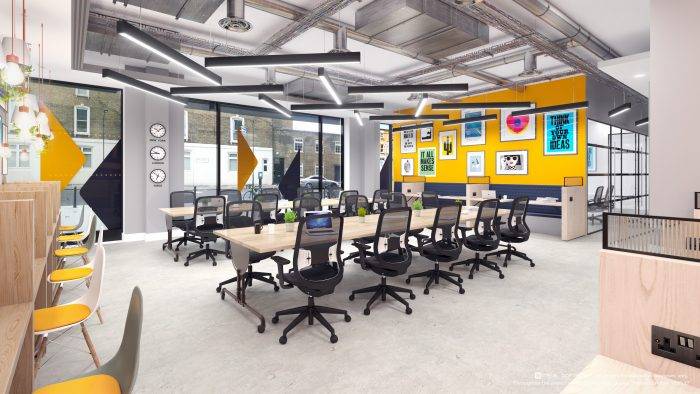 Coworking is not the norm yet, but it is headed that direction. In fact, a sign of its success is the fact that it has moved from being labelled a fad to asking if it is a bubble about to burst. Here’s a short answer: it is not going to go pop, fizzle out or run out of steam anytime soon. Why would it? Coworking is not something driven by real estate and developers. It reflects how our society is changing.
Coworking is not the norm yet, but it is headed that direction. In fact, a sign of its success is the fact that it has moved from being labelled a fad to asking if it is a bubble about to burst. Here’s a short answer: it is not going to go pop, fizzle out or run out of steam anytime soon. Why would it? Coworking is not something driven by real estate and developers. It reflects how our society is changing.
Coworking is developing as a model for how we use workspaces in parallel with the concept of Never have the lines around how we work, where live and how we each co-exist been so blurred. It is not a generation thing either – we are all adapting to new ways of working and living and therefore, people and not organisations are driving a change in social, psychological and physical needs.
Does the property market understand this? The market might not grasp the detail around behaviours, but it has understood that the coworking concept is booming, shows no sign of slowing and is trying to adapt as quickly as possible to meet the demand. The operators do get it. But even they need to move fast because the demand is outpacing supply. Hence, they need to be tuned into the reasons for the growing demand for coworking.
 How we use technology, how we interact is having an impact on society and therefore the workplace too. The media is full of programmes, podcasts, articles, research and reports about loneliness, depression an anxiety being linked to social media, how we work and issues around wellbeing. It’s no coincidence that there is a rise of depression and anxiety within younger people in particular – it has been referred to as a symptom of ‘modern loneliness’. It is not unique to the UK, but we have been dubbed the loneliest country in Europe. And it is not good for us either. Research by Julianne Holt-Lunstad at Brigham Young University in the US suggests people that feel a sense of belonging and trust in their community have a better health, while those that feel isolated are at risk of increased blood pressure, higher cholesterol and depression.
How we use technology, how we interact is having an impact on society and therefore the workplace too. The media is full of programmes, podcasts, articles, research and reports about loneliness, depression an anxiety being linked to social media, how we work and issues around wellbeing. It’s no coincidence that there is a rise of depression and anxiety within younger people in particular – it has been referred to as a symptom of ‘modern loneliness’. It is not unique to the UK, but we have been dubbed the loneliest country in Europe. And it is not good for us either. Research by Julianne Holt-Lunstad at Brigham Young University in the US suggests people that feel a sense of belonging and trust in their community have a better health, while those that feel isolated are at risk of increased blood pressure, higher cholesterol and depression.
The reaction to this is a desire amongst the ‘workers’ to create a sense of belonging: communities that thrive. It doesn’t matter if it’s where you ‘live’ or where you ‘work’ it is the idea of a community, shared purpose, ideals that counts. This is one reason why coworking just works. It is no longer just for freelancers. Organisations, often with some entrepreneurial flare, now embrace coworking. It is organic, and solution focussed with its roots in co-living.
 This free flow thinking is not the usual pattern for the property market. But is about finding a balance. We are not going to abandon totally the corporate workspace, but we are choosing more flexible options about how we work and we’re looking to the rest of Europe for ideas. For example, co-housing schemes started in the Netherlands & Sweden in the 1960s – predominately to encourage interaction in older generations to fight social isolation. Like co-living, coworking improves wellbeing through a sense of belonging – so with the current momentum and positive outcomes there is no reason for the coworking movement to ever ‘stop’.
This free flow thinking is not the usual pattern for the property market. But is about finding a balance. We are not going to abandon totally the corporate workspace, but we are choosing more flexible options about how we work and we’re looking to the rest of Europe for ideas. For example, co-housing schemes started in the Netherlands & Sweden in the 1960s – predominately to encourage interaction in older generations to fight social isolation. Like co-living, coworking improves wellbeing through a sense of belonging – so with the current momentum and positive outcomes there is no reason for the coworking movement to ever ‘stop’.
The danger to the success of coworking is saturation. Yes, coworking is a success story right now, the stats in London indicate flexible workspace operators occupy around 10.7 million square feet, running at around 80 percent capacity and that WeWork is the largest corporate office occupier at 2.6m sq. ft. of space. However, the risk is that by ignoring the reasons why society is driving coworking the property market flogs it to death.
The answer is for the providers to allow the solution to be driven by the end users. The ‘workers’ and their employers have the upper hand because they decide how and where they want to work. The user is looking for ‘their type of people’ to be surrounded by. It is the operators’ job to attract those people.
It is not a coworking bubble. And it is not going to burst, fizzle or pop. It is going to keep growing, adapting and flexing and I doubt it will fit any formal defined shape for some time yet.
___________________________________
 Kathryn O’Callaghan-Mills is design director at Area and is speaking at the GCUC co-working conference in London on 25 September
Kathryn O’Callaghan-Mills is design director at Area and is speaking at the GCUC co-working conference in London on 25 September














September 13, 2018
You should not expect the coworking bubble to burst anytime soon
by Kathryn O'Callaghan-Mills • Comment, Coworking, Property, Workplace design
Coworking is developing as a model for how we use workspaces in parallel with the concept of Never have the lines around how we work, where live and how we each co-exist been so blurred. It is not a generation thing either – we are all adapting to new ways of working and living and therefore, people and not organisations are driving a change in social, psychological and physical needs.
Does the property market understand this? The market might not grasp the detail around behaviours, but it has understood that the coworking concept is booming, shows no sign of slowing and is trying to adapt as quickly as possible to meet the demand. The operators do get it. But even they need to move fast because the demand is outpacing supply. Hence, they need to be tuned into the reasons for the growing demand for coworking.
The reaction to this is a desire amongst the ‘workers’ to create a sense of belonging: communities that thrive. It doesn’t matter if it’s where you ‘live’ or where you ‘work’ it is the idea of a community, shared purpose, ideals that counts. This is one reason why coworking just works. It is no longer just for freelancers. Organisations, often with some entrepreneurial flare, now embrace coworking. It is organic, and solution focussed with its roots in co-living.
The danger to the success of coworking is saturation. Yes, coworking is a success story right now, the stats in London indicate flexible workspace operators occupy around 10.7 million square feet, running at around 80 percent capacity and that WeWork is the largest corporate office occupier at 2.6m sq. ft. of space. However, the risk is that by ignoring the reasons why society is driving coworking the property market flogs it to death.
The answer is for the providers to allow the solution to be driven by the end users. The ‘workers’ and their employers have the upper hand because they decide how and where they want to work. The user is looking for ‘their type of people’ to be surrounded by. It is the operators’ job to attract those people.
It is not a coworking bubble. And it is not going to burst, fizzle or pop. It is going to keep growing, adapting and flexing and I doubt it will fit any formal defined shape for some time yet.
___________________________________